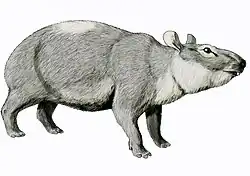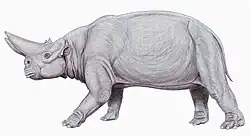Pliohyrax
| Pliohyrax Temporal range:
| |
|---|---|
| Pliohyrax graecus | |

| |
| Life restoration | |
| Scientific classification | |
| Kingdom: | Animalia |
| Phylum: | Chordata |
| Class: | Mammalia |
| Order: | Hyracoidea |
| Family: | †Pliohyracidae |
| Subfamily: | †Pliohyracinae |
| Genus: | † Osborn, 1899 |
| Species | |
| Synonyms | |
| |
Pliohyrax, is a genus of hyracoids (the cavy-like group of animals most closely related to elephants and manatees). It grew to sizes greatly exceeding those of any living hyrax, though it was by no means the largest member of this family.
Fossils of this Miocene-Pliocene herbivore have been found in Afghanistan, France, and Turkey.[4] In Spain, Pliohyrax graecus is among the large mammals species found in the Almenara site, deposited during the Messinian salinity crisis, together with Macaca sp., Bovidae indet., cf. Nyctereutes sp., and Felidae indet.[5]
Palaeoecology
Dental microwear of the boar-sized Pliohyrax graecus from the fossil sites of Pikermi and Samos in Greece indicates that this species had a grazing diet.[6]
References
- ^ a b "Genus †Pliohyrax". The Taxonomicon. April 2012. Retrieved 25 August 2012.
- ^ "Soblay, excavation from 1949: MN 10, France". The Taxonomicon. Archived from the original on 18 December 2012. Retrieved 25 August 2012.
- ^ Pickford, M.; Senut, B. (2018). "Afrohyrax namibensis (Hyracoidea, Mammalia) from the Early Miocene of Elisabethfeld and Fiskus, Sperrgebiet, Namibia" (PDF). Communications of the Geological Survey of Namibia. 18: 93–112.
- ^ "Pliohyrax". Paleobiology Database. Retrieved 25 August 2012.
- ^ Agustí, Jordi; Garcés, Miguel; Krijgsman, Wout (29 August 2006). "Evidence for African–Iberian exchanges during the Messinian in the Spanish mammalian record". Palaeogeography, Palaeoclimatology, Palaeoecology. 238 (1–4): 5–14. Bibcode:2006PPP...238....5A. doi:10.1016/j.palaeo.2006.03.013. Retrieved 18 August 2025 – via ResearchGate.
- ^ Solounias, Nikos; Rivals, Florent; Semprebon, Gina M. (1 January 2010). "Dietary interpretation and paleoecology of herbivores from Pikermi and Samos (late Miocene of Greece)". Paleobiology. 36 (1): 113–136. doi:10.1666/0094-8373-36.1.113. ISSN 0094-8373. Retrieved 14 August 2025 – via BioOne Digital Library.
